INFORMATION REQUIRED IN PROXY STATEMENT
SCHEDULE 14A INFORMATION
Proxy Statement Pursuant to Section 14(a) of the Securities
Filed by the Registrant x
Filed by a Party other than the Registrant o
Check the appropriate box:
| o Preliminary Proxy Statement | o Confidential, for Use of the Commission Only (as permitted by Rule 14a-6(e)(2)) | |
| o Definitive Proxy Statement | ||
| x Definitive Additional Materials | ||
| o Soliciting Material under Rule 14a-12 | ||
Post Properties, Inc.
Payment of Filing Fee (Check the appropriate box):
| x | No fee required. |
| o | Fee computed on table below per Exchange Act Rules 14a-6(i)(1) and 0-11. |
| (1) | Title of each class of securities to which transaction applies: |
| (2) | Aggregate number of securities to which transaction applies: |
| (3) | Per unit price or other underlying value of transaction computed pursuant to Exchange Act Rule 0-11 (set forth the amount on which the filing fee is calculated and state how it was determined): |
| (4) | Proposed maximum aggregate value of transaction: |
| (5) | Total fee paid: |
| o | Fee paid previously with preliminary materials. |
| o | Check box if any part of the fee is offset as provided by Exchange Act Rule 0-11(a)(2) and identify the filing for which the offsetting fee was paid previously. Identify the previous filing by registration statement number, or the Form or Schedule and the date of its filing. |
| (1) | Amount Previously Paid: |
| (2) | Form, Schedule or Registration Statement No.: |
| (3) | Filing Party: |
| (4) | Date Filed: |
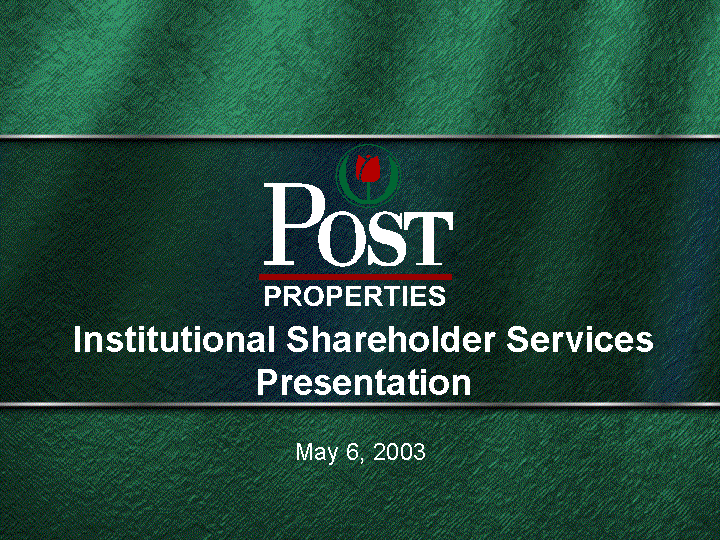
| CONFIDENTIAL Institutional Shareholder Services Presentation May 6, 2003 |
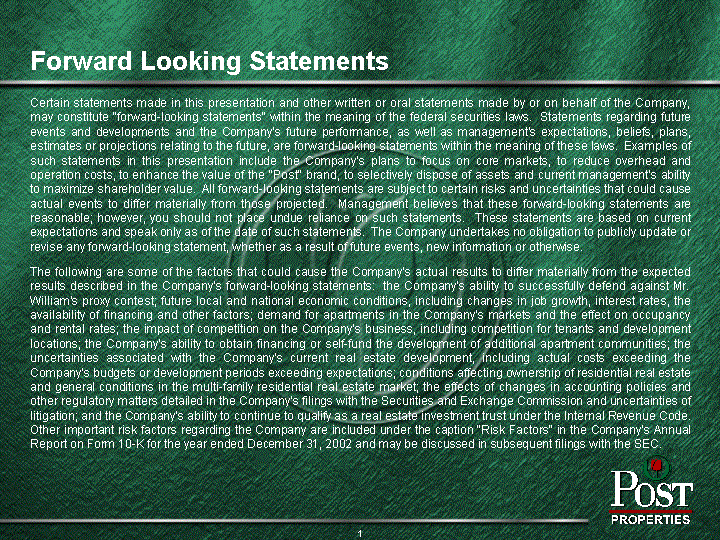
| Certain statements made in this presentation and other written or oral statements made by or on behalf of the Company, may constitute "forward-looking statements" within the meaning of the federal securities laws. Statements regarding future events and developments and the Company's future performance, as well as management's expectations, beliefs, plans, estimates or projections relating to the future, are forward-looking statements within the meaning of these laws. Examples of such statements in this presentation include the Company's plans to focus on core markets, to reduce overhead and operation costs, to enhance the value of the "Post" brand, to selectively dispose of assets and current management's ability to maximize shareholder value. All forward-looking statements are subject to certain risks and uncertainties that could cause actual events to differ materially from those projected. Management believes that these forward-looking statements are reasonable; however, you should not place undue reliance on such statements. These statements are based on current expectations and speak only as of the date of such statements. The Company undertakes no obligation to publicly update or revise any forward-looking statement, whether as a result of future events, new information or otherwise. The following are some of the factors that could cause the Company's actual results to differ materially from the expected results described in the Company's forward-looking statements: the Company's ability to successfully defend against Mr. William's proxy contest; future local and national economic conditions, including changes in job growth, interest rates, the availability of financing and other factors; demand for apartments in the Company's markets and the effect on occupancy and rental rates; the impact of competition on the Company's business, including competition for tenants and development locations; the Company's ability to obtain financing or self-fund the development of additional apartment communities; the uncertainties associated with the Company's current real estate development, including actual costs exceeding the Company's budgets or development periods exceeding expectations; conditions affecting ownership of residential real estate and general conditions in the multi-family residential real estate market; the effects of changes in accounting policies and other regulatory matters detailed in the Company's filings with the Securities and Exchange Commission and uncertainties of litigation; and the Company's ability to continue to qualify as a real estate investment trust under the Internal Revenue Code. Other important risk factors regarding the Company are included under the caption "Risk Factors" in the Company's Annual Report on Form 10-K for the year ended December 31, 2002 and may be discussed in subsequent filings with the SEC. Forward Looking Statements |
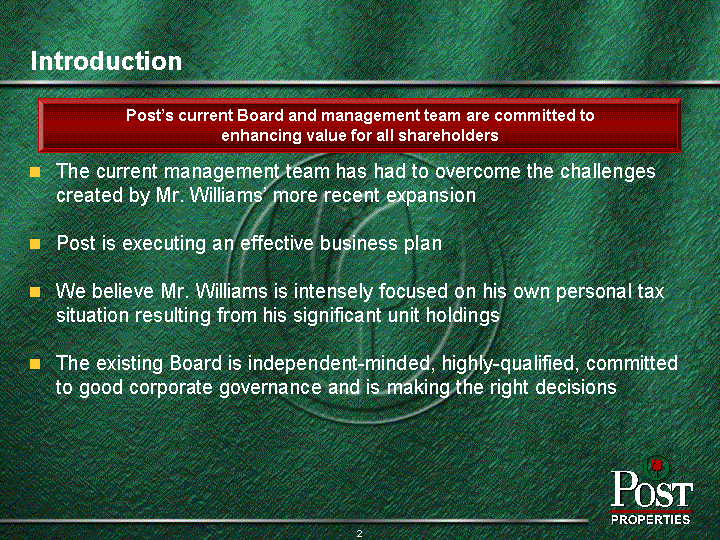
| Post's current Board and management team are committed to enhancing value for all shareholders Introduction The current management team has had to overcome the challenges created by Mr. Williams' more recent expansion Post is executing an effective business plan We believe Mr. Williams is intensely focused on his own personal tax situation resulting from his significant unit holdings The existing Board is independent-minded, highly-qualified, committed to good corporate governance and is making the right decisions |
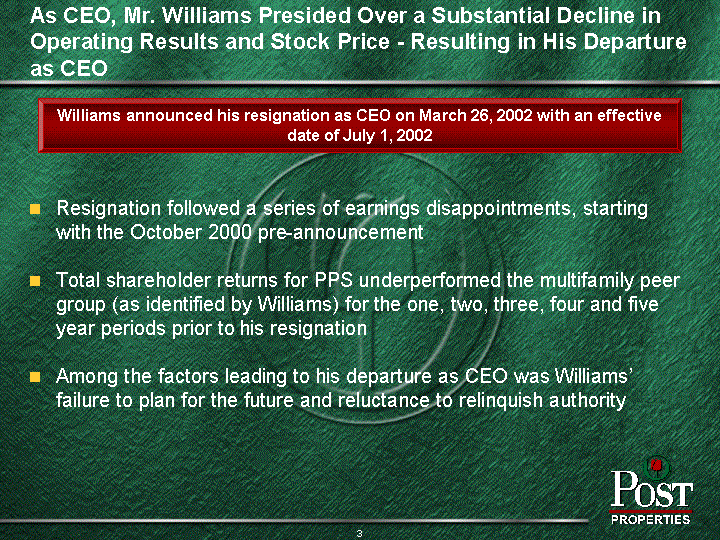
| Williams announced his resignation as CEO on March 26, 2002 with an effective date of July 1, 2002 As CEO, Mr. Williams Presided Over a Substantial Decline in Operating Results and Stock Price - Resulting in His Departure as CEO Resignation followed a series of earnings disappointments, starting with the October 2000 pre-announcement Total shareholder returns for PPS underperformed the multifamily peer group (as identified by Williams) for the one, two, three, four and five year periods prior to his resignation Among the factors leading to his departure as CEO was Williams' failure to plan for the future and reluctance to relinquish authority |

| Date Post Properties, Inc. As CEO, Mr. Williams Presided Over a Substantial Decline in Operating Results and Stock Price - Resulting in His Departure as CEO 10/2/00: Post's earnings pre- announcement 3/26/02: Williams announces his resignation as CEO of Post, effective July 1, 2002 7/1/02: Williams resigns as Post CEO and Stockert assumes his current position as CEO of Post 2/21/03: Williams resigns role as Post's Chairman and is elected Chairman Emeritus of Post (1) Source: Factset. For the period beginning on September 1, 2000 to March 31, 2003 |
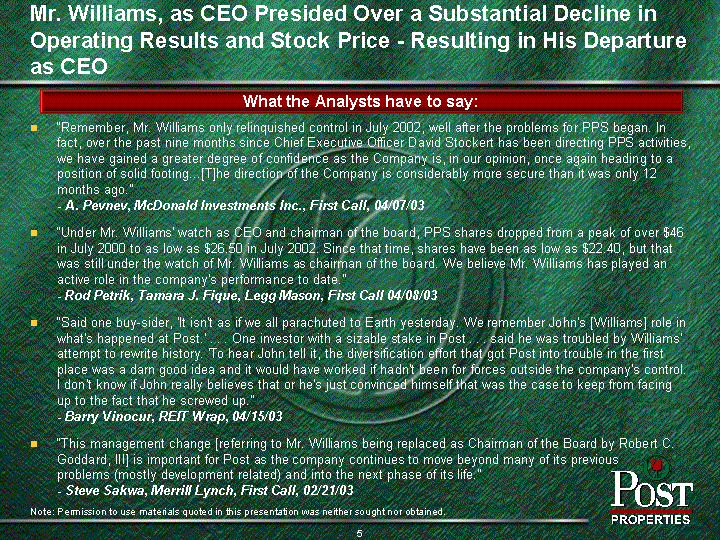
| Mr. Williams, as CEO Presided Over a Substantial Decline in Operating Results and Stock Price - Resulting in His Departure as CEO "Remember, Mr. Williams only relinquished control in July 2002, well after the problems for PPS began. In fact, over the past nine months since Chief Executive Officer David Stockert has been directing PPS activities, we have gained a greater degree of confidence as the Company is, in our opinion, once again heading to a position of solid footing...[T]he direction of the Company is considerably more secure than it was only 12 months ago." - - A. Pevnev, McDonald Investments Inc., First Call, 04/07/03 "Under Mr. Williams' watch as CEO and chairman of the board, PPS shares dropped from a peak of over $46 in July 2000 to as low as $26.50 in July 2002. Since that time, shares have been as low as $22.40, but that was still under the watch of Mr. Williams as chairman of the board. We believe Mr. Williams has played an active role in the company's performance to date." - - Rod Petrik, Tamara J. Fique, Legg Mason, First Call 04/08/03 "Said one buy-sider, 'It isn't as if we all parachuted to Earth yesterday. We remember John's [Williams] role in what's happened at Post.' . . . One investor with a sizable stake in Post . . . said he was troubled by Williams' attempt to rewrite history. 'To hear John tell it, the diversification effort that got Post into trouble in the first place was a darn good idea and it would have worked if hadn't been for forces outside the company's control. I don't know if John really believes that or he's just convinced himself that was the case to keep from facing up to the fact that he screwed up." - - Barry Vinocur, REIT Wrap, 04/15/03 "This management change [referring to Mr. Williams being replaced as Chairman of the Board by Robert C. Goddard, III] is important for Post as the company continues to move beyond many of its previous problems (mostly development related) and into the next phase of its life." - - Steve Sakwa, Merrill Lynch, First Call, 02/21/03 What the Analysts have to say: Note: Permission to use materials quoted in this presentation was neither sought nor obtained. |

| The Current Management Team Has Had to Overcome the Challenges of Mr. Williams' More Recent Geographic and Product- Type Expansion Under Mr. Williams, Post pursued an overly aggressive expansion of development initiatives into several unfamiliar markets, which led to significant cost overruns Spread too thin in markets where Post lacked critical mass, development expertise or local contacts At various times during the year 2000, Post had as many as 18 construction projects underway in 11 separate cities, involving total construction spending of some $600 million Major shift in product focus to new urbanism and mixed-use requiring significantly more complicated mid-rise and high-rise (heavy frame) construction expertise than Post had at the time Inadequate asset management given the scope of Post's geographic and product-type expansion |
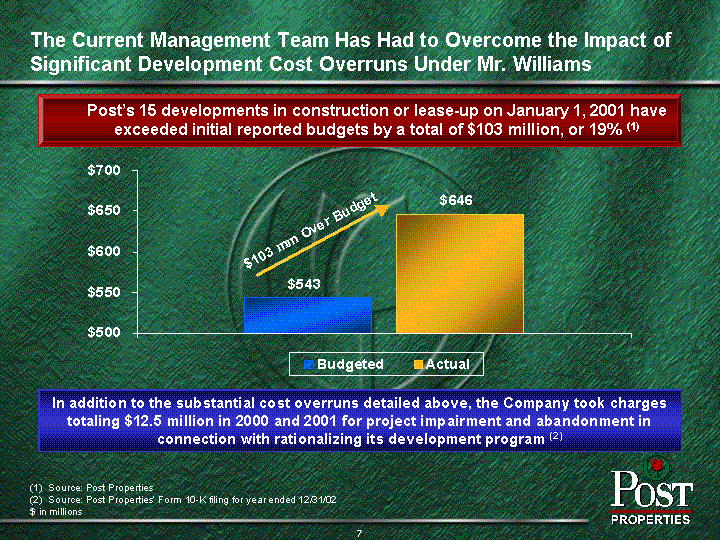
| (1) Source: Post Properties (2) Source: Post Properties' Form 10-K filing for year ended 12/31/02 $ in millions The Current Management Team Has Had to Overcome the Impact of Significant Development Cost Overruns Under Mr. Williams Legend Text Budgeted Actual 543 646 $103 mm Over Budget Post's 15 developments in construction or lease-up on January 1, 2001 have exceeded initial reported budgets by a total of $103 million, or 19% (1) In addition to the substantial cost overruns detailed above, the Company took charges totaling $12.5 million in 2000 and 2001 for project impairment and abandonment in connection with rationalizing its development program (2) |
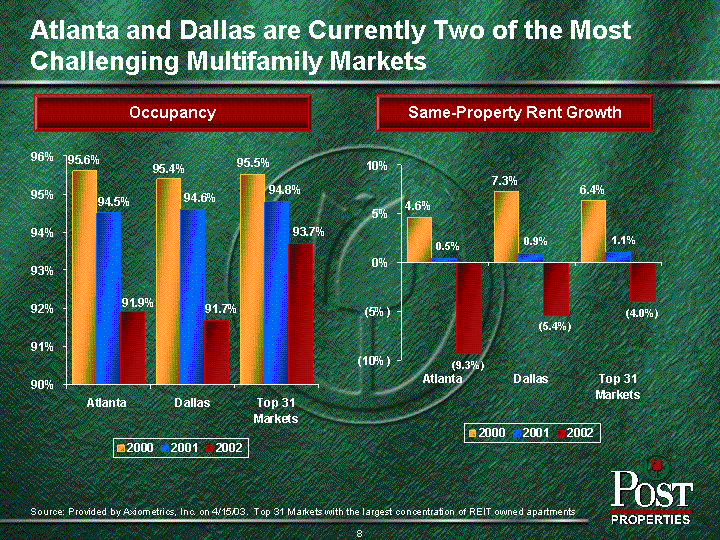
| Source: Provided by Axiometrics, Inc. on 4/15/03. Top 31 Markets with the largest concentration of REIT owned apartments 2000 2001 2002 Atlanta 0.956 0.945 0.919 Dallas 0.954 0.946 0.917 Top 31 Markets 0.955 0.948 0.937 2000 2001 2002 Atlanta 0.046 0.005 -0.093 Dallas 0.073 0.009 -0.054 Top 31 Markets 0.064 0.011 -0.04 Atlanta and Dallas are Currently Two of the Most Challenging Multifamily Markets Occupancy Same-Property Rent Growth |
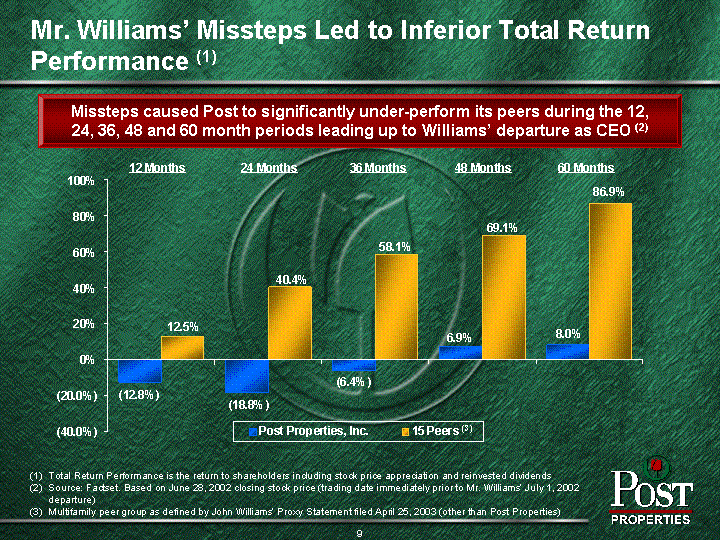
| Missteps caused Post to significantly under-perform its peers during the 12, 24, 36, 48 and 60 month periods leading up to Williams' departure as CEO (2) Legend Text Post Properties, Inc. 15 Peers 12 Months -12.8 12.5 24 Months -18.8 40.4 36 Months -6.4 58.1 48 Months 6.9 69.1 60 Months 8 86.9 (3) Mr. Williams' Missteps Led to Inferior Total Return Performance (1) (1) Total Return Performance is the return to shareholders including stock price appreciation and reinvested dividends (2) Source: Factset. Based on June 28, 2002 closing stock price (trading date immediately prior to Mr. Williams' July 1, 2002 departure) (3) Multifamily peer group as defined by John Williams' Proxy Statement filed April 25, 2003 (other than Post Properties) |
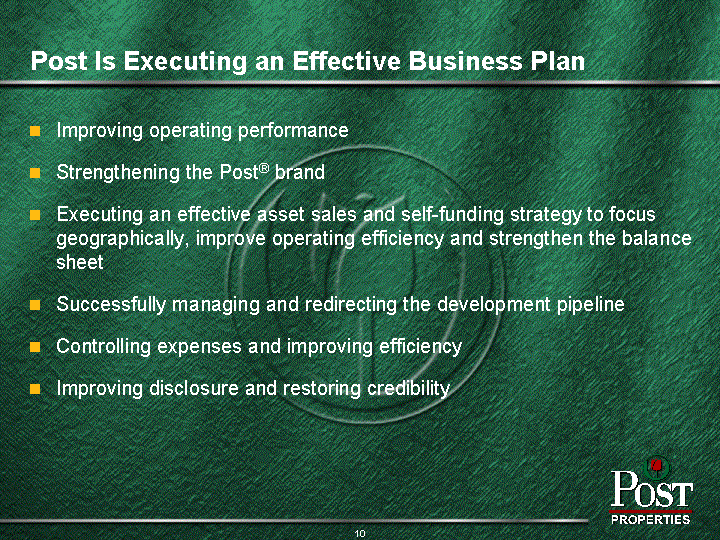
| Post Is Executing an Effective Business Plan Improving operating performance Strengthening the Post(r) brand Executing an effective asset sales and self-funding strategy to focus geographically, improve operating efficiency and strengthen the balance sheet Successfully managing and redirecting the development pipeline Controlling expenses and improving efficiency Improving disclosure and restoring credibility |
The Property Management Team Is Improving Relative Performance in Atlanta and Dallas
During the second half of 2002, Post outperformed the peer group average in
| 20.0% | ATLANTA | |||||||||||||||||||||||||||||||||||||||||||||||
| 15.0% | 3Q02 | 4Q02 | ||||||||||||||||||||||||||||||||||||||||||||||
| 10.0% | ||||||||||||||||||||||||||||||||||||||||||||||||
| 5.0% | ||||||||||||||||||||||||||||||||||||||||||||||||
| 0.0% | PPS | EQR | GBP | AML | AIV | SMT | SMT | PPS | AML | EQR | GBP | |||||||||||||||||||||||||||||||||||||
| (5.0%) | ||||||||||||||||||||||||||||||||||||||||||||||||
| (10.0%) | Avg. | (10.4%) | ||||||||||||||||||||||||||||||||||||||||||||||
| (15.0%) | (13.2%) | (14.9%) | (14.9%) | (15.3%) | (15.9%) | (15.4%) | (12.3%) | (12.7%) | (14.7%) | |||||||||||||||||||||||||||||||||||||||
| (20.0%) | (18.2%) | (18.9%) | ||||||||||||||||||||||||||||||||||||||||||||||
| (25.0%) | ||||||||||||||||||||||||||||||||||||||||||||||||
| (30.0%) | ||||||||||||||||||||||||||||||||||||||||||||||||
| (35.0%) | ||||||||||||||||||||||||||||||||||||||||||||||||
[Continued from above table, first column(s) repeated]
| 20.0% | ATLANTA | |||||||||||||||||||||||||||||||||||||||||||||||
| 15.0% | 4Q02 | |||||||||||||||||||||||||||||||||||||||||||||||
| 10.0% | ||||||||||||||||||||||||||||||||||||||||||||||||
| 5.0% | ||||||||||||||||||||||||||||||||||||||||||||||||
| 0.0% | AIV | |||||||||||||||||||||||||||||||||||||||||||||||
| (5.0%) | ||||||||||||||||||||||||||||||||||||||||||||||||
| (10.0%) | Avg. | |||||||||||||||||||||||||||||||||||||||||||||||
| (15.0%) | (16.5%) | |||||||||||||||||||||||||||||||||||||||||||||||
| (20.0%) | ||||||||||||||||||||||||||||||||||||||||||||||||
| (25.0%) | ||||||||||||||||||||||||||||||||||||||||||||||||
| (30.0%) | ||||||||||||||||||||||||||||||||||||||||||||||||
| (35.0%) | (30.1%) | |||||||||||||||||||||||||||||||||||||||||||||||
| 20.0% | DALLAS | |||||||||||||||||||||||||||||||||||||||||||||||
| 15.0% | 3Q02 | 14.7%(1) | 4Q02 | |||||||||||||||||||||||||||||||||||||||||||||
| 10.0% | ||||||||||||||||||||||||||||||||||||||||||||||||
| 5.0% | ||||||||||||||||||||||||||||||||||||||||||||||||
| 0.0% | PPS | UDR | AML | EQR | CPT | TCR | AIV | PPS | UDR | AIV | AML | |||||||||||||||||||||||||||||||||||||
| (5.0%) | (5.1%) | (5.7%) | Avg. | (5.8%) | (8.5%) | |||||||||||||||||||||||||||||||||||||||||||
| (10.0%) | (9.7%) | (11.3%) | (12.6%) | (12.8%) | (10.7%) | |||||||||||||||||||||||||||||||||||||||||||
| (15.0%) | ||||||||||||||||||||||||||||||||||||||||||||||||
| (20.0%) | (17.8%) | |||||||||||||||||||||||||||||||||||||||||||||||
| (25.0%) | (27.2%) | |||||||||||||||||||||||||||||||||||||||||||||||
| (30.0%) | ||||||||||||||||||||||||||||||||||||||||||||||||
| (35.0%) | ||||||||||||||||||||||||||||||||||||||||||||||||
[Continued from above table, first column(s) repeated]
| 20.0% | DALLAS | |||||||||||||||||||||||||||||||||||||||||||||||
| 15.0% | 4Q02 | |||||||||||||||||||||||||||||||||||||||||||||||
| 10.0% | ||||||||||||||||||||||||||||||||||||||||||||||||
| 5.0% | ||||||||||||||||||||||||||||||||||||||||||||||||
| 0.0% | TCR | EQR | CPT | |||||||||||||||||||||||||||||||||||||||||||||
| (5.0%) | Avg. | |||||||||||||||||||||||||||||||||||||||||||||||
| (10.0%) | (12.9%) | (7.6%) | ||||||||||||||||||||||||||||||||||||||||||||||
| (15.0%) | (14.7%) | (15.4%) | ||||||||||||||||||||||||||||||||||||||||||||||
| (20.0%) | ||||||||||||||||||||||||||||||||||||||||||||||||
| (25.0%) | ||||||||||||||||||||||||||||||||||||||||||||||||
| (30.0%) | ||||||||||||||||||||||||||||||||||||||||||||||||
| (35.0%) | ||||||||||||||||||||||||||||||||||||||||||||||||
| (1) | Includes property tax savings recorded in the fourth quarter. Excluding these savings, Post’s same-property NOI would have increased by 4.3% |
Source: Based on each of the companies’ respective Supplemental Financial Data Packages for periods ended 9/30/02 and 12/31/02, other than EQR, which has reported the relevant information in its Press Releases dated 11/4/02 and 2/5/03. Graphs include apartment REITs with at least 2,000 apartments in Atlanta and Dallas that report same-property NOI for those markets. NOI is a non-GAAP financial measure, and Table 1 in the Appendix to this presentation sets forth a reconciliation of same-property NOI to the most directly comparable GAAP financial measure.
11

| PPS -0.022 AIV 0 AML 0.001 CPT 0.011 UDR 0.018 SMT 0.024 EQR 0.025 BRE 0.025 GBP 0.035 MAA 0.043 ASN 0.047 TCT 0.063 ESS 0.063 TCR 0.068 AVB 0.071 HME 0.094 Second Half 2002 Same-Property Expense Growth (1) Includes property tax savings recorded in the fourth quarter of 2002. Excluding these savings, Post's same-property operating expenses would have declined an average of 0.5% in the second half of 2002, compared to the same period in 2001. Source: Based on each of the companies' respective Supplemental Financial Data Packages for periods ended 9/30/02 and 12/31/02, other than for EQR, HME and TCT, which have reported the relevant information in their respective Press Releases (EQR Press Releases dated 11/4/02 and 2/5/03, HME Press Releases dated 11/1/02 and 2/7/03, TCT Press Releases dated 10/31/02 and 2/6/03). 2H'02 results are an average of 3Q'02 and 4Q'02 amounts During the second half of 2002, Post significantly outperformed its peers in terms of controlling its same-property operating expenses (1) Controlling Expenses and Improving Efficiency |
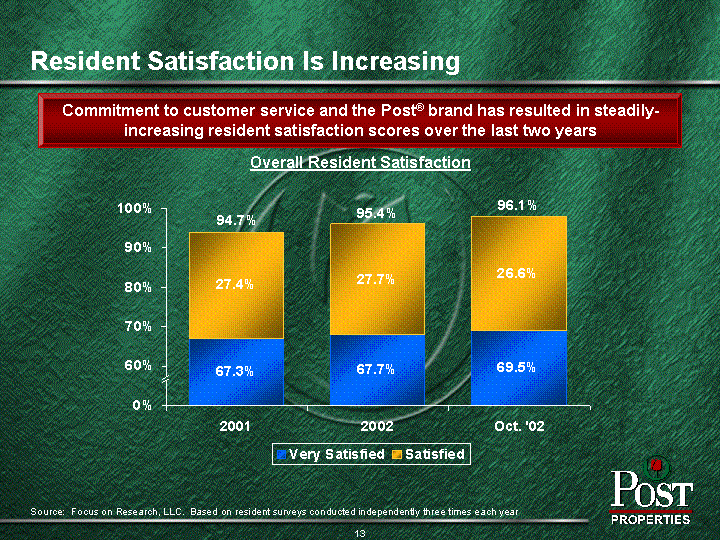
| Very Satisfied Satisfied 2001 0.67 0.27 2002 0.68 0.28 Oct. '02 0.69 0.29 Commitment to customer service and the Post(r) brand has resulted in steadily- increasing resident satisfaction scores over the last two years Overall Resident Satisfaction 94.7% 95.4% 96.1% Resident Satisfaction Is Increasing Source: Focus on Research, LLC. Based on resident surveys conducted independently three times each year |
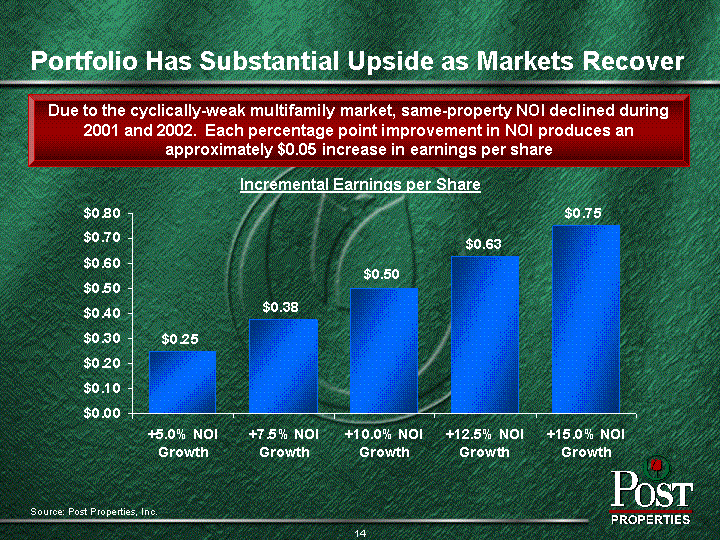
| Incremental Earnings per Share Overall +5.0% NOI Growth 0.25 +7.5% NOI Growth 0.375 +10.0% NOI Growth 0.5 +12.5% NOI Growth 0.625 +15.0% NOI Growth 0.75 Due to the cyclically-weak multifamily market, same-property NOI declined during 2001 and 2002. Each percentage point improvement in NOI produces an approximately $0.05 increase in earnings per share Portfolio Has Substantial Upside as Markets Recover Source: Post Properties, Inc. |
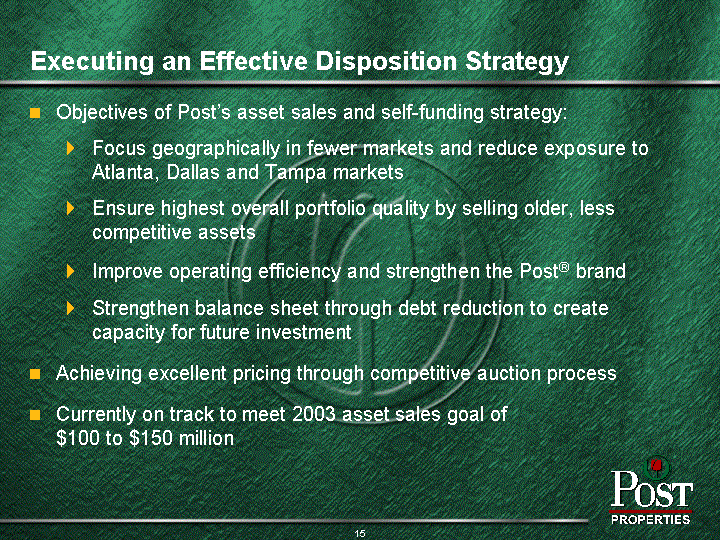
| Executing an Effective Disposition Strategy Objectives of Post's asset sales and self-funding strategy: Focus geographically in fewer markets and reduce exposure to Atlanta, Dallas and Tampa markets Ensure highest overall portfolio quality by selling older, less competitive assets Improve operating efficiency and strengthen the Post(r) brand Strengthen balance sheet through debt reduction to create capacity for future investment Achieving excellent pricing through competitive auction process Currently on track to meet 2003 asset sales goal of $100 to $150 million |

| Source: Post Properties, Inc. Maximizing Sales Pricing Through a Competitive Auction Process Since January 1, 2000, Post has generated $572 million of gross proceeds from the sale of 23 multifamily properties 5 highly-qualified brokerage firms used A very competitive auction process with, on average: More than 250 investors contacted per transaction More than 50 investor information requests More than 10 offers received 4 bidders invited for "best & final" round of bids Seller commissions of approximately 1% Management and Board have evaluated comprehensive asset sales data for each of the Company's markets and believe the Company is achieving attractive pricing on both a per unit and per square foot basis |
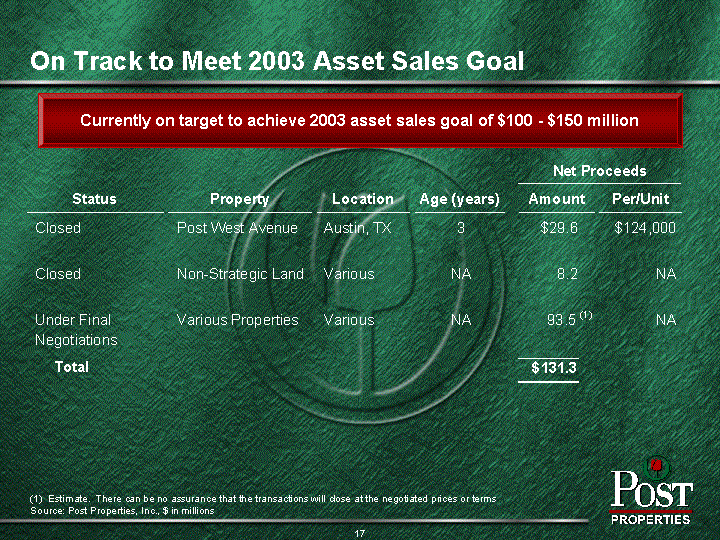
| (1) Estimate. There can be no assurance that the transactions will close at the negotiated prices or terms Source: Post Properties, Inc., $ in millions On Track to Meet 2003 Asset Sales Goal Currently on target to achieve 2003 asset sales goal of $100 - $150 million |
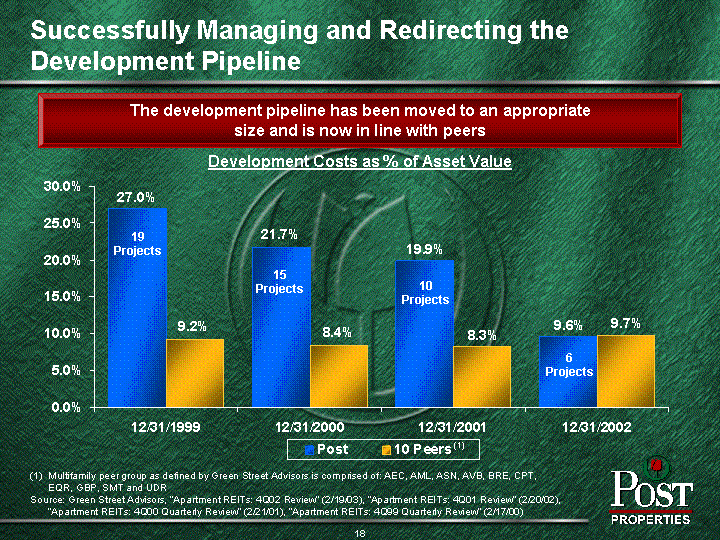
| Post 10 Peers 12/31/1999 0.27 0.092 12/31/2000 0.217 0.084 12/31/2001 0.199 0.083 12/31/2002 0.096 0.097 The development pipeline has been moved to an appropriate size and is now in line with peers Development Costs as % of Asset Value (1) 19 Projects 15 Projects 10 Projects 6 Projects (1) Multifamily peer group as defined by Green Street Advisors is comprised of: AEC, AML, ASN, AVB, BRE, CPT, EQR, GBP, SMT and UDR Source: Green Street Advisors, "Apartment REITs: 4Q02 Review" (2/19/03), "Apartment REITs: 4Q01 Review" (2/20/02), "Apartment REITs: 4Q00 Quarterly Review" (2/21/01), "Apartment REITs: 4Q99 Quarterly Review" (2/17/00) Successfully Managing and Redirecting the Development Pipeline |

| Source: Post Properties, Inc., $ in millions Projects started since January 1, 2001 are on-time and on-budget Development Process Back on Track |

| (1) Reflects internal personnel and associated costs capitalized to construction and development activities Source: Post Properties' Form 10-K filing for the year ended 12/31/02. Headcount reduction per Post Properties, Inc. $ in millions In 2002, personnel and administrative costs were reduced by 28%, and headcount was reduced by 15% G&A Expense Capitalized Internal Personnel/Costs 2001 13.3 13.8 2002 14.4 5.2 Headcount YE 2001 1235 YE 2002 1050 $27.1 $19.6 (28%) (15%) (1) Controlling Expenses and Improving Efficiency |

| Post's improved disclosure and transparency are helping to restore credibility with investors and Wall Street Improving Disclosure and Restoring Credibility Established new quarterly supplemental reporting package starting 2Q'03 Expanded balance sheet disclosure Public debt financial covenant calculations Expanded disclosure on unconsolidated real estate entities Increased supplemental same-property results by market Enhanced information on capital expenditures |

| We believe Mr. Williams is motivated by self-interest, not shareholders' interest We Believe Mr. Williams Is Intensely Focused on His Own Personal Circumstances We believe Mr. Williams is motivated by an inability to relinquish control to his successors We believe Mr. Williams is also motivated by a desire to regain control of Post to control his personal tax situation Williams is the largest unitholder and has substantial negative basis which could trigger taxable gains resulting from sales of Company assets or a sale of the Company in certain cases We believe Mr. Williams is seeking to gain control of the Company without offering a premium to shareholders |
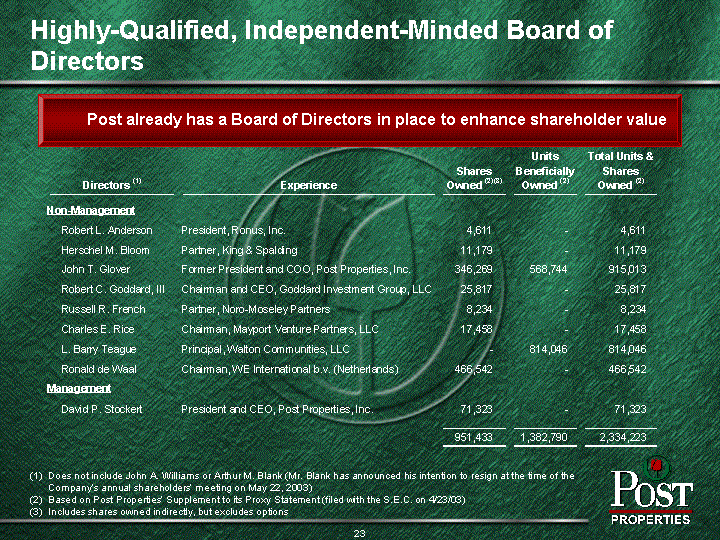
| (1) Does not include John A. Williams or Arthur M. Blank (Mr. Blank has announced his intention to resign at the time of the Company's annual shareholders' meeting on May 22, 2003) (2) Based on Post Properties' Supplement to its Proxy Statement (filed with the S.E.C. on 4/23/03) (3) Includes shares owned indirectly, but excludes options Post already has a Board of Directors in place to enhance shareholder value Highly-Qualified, Independent-Minded Board of Directors |
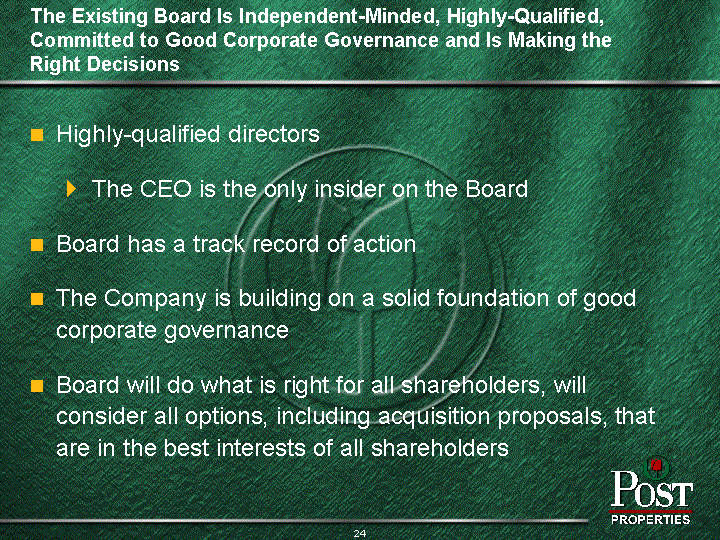
| The Existing Board Is Independent-Minded, Highly-Qualified, Committed to Good Corporate Governance and Is Making the Right Decisions Highly-qualified directors The CEO is the only insider on the Board Board has a track record of action The Company is building on a solid foundation of good corporate governance Board will do what is right for all shareholders, will consider all options, including acquisition proposals, that are in the best interests of all shareholders |
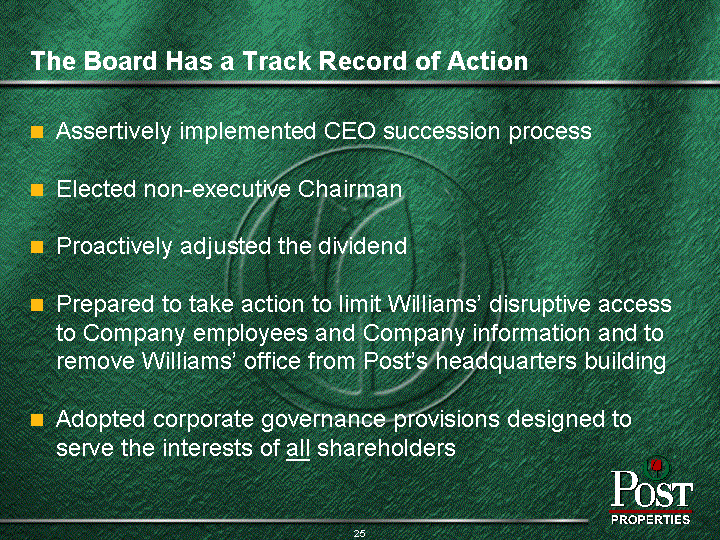
| The Board Has a Track Record of Action Assertively implemented CEO succession process Elected non-executive Chairman Proactively adjusted the dividend Prepared to take action to limit Williams' disruptive access to Company employees and Company information and to remove Williams' office from Post's headquarters building Adopted corporate governance provisions designed to serve the interests of all shareholders |
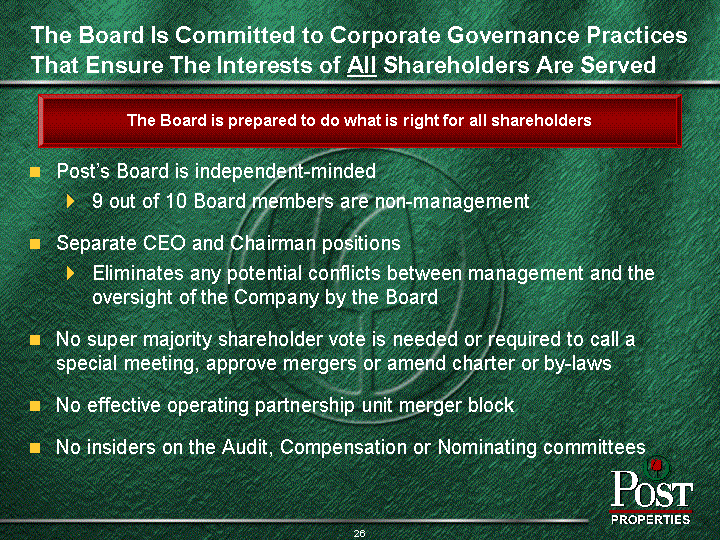
| The Board is prepared to do what is right for all shareholders The Board Is Committed to Corporate Governance Practices That Ensure The Interests of All Shareholders Are Served Post's Board is independent-minded 9 out of 10 Board members are non-management Separate CEO and Chairman positions Eliminates any potential conflicts between management and the oversight of the Company by the Board No super majority shareholder vote is needed or required to call a special meeting, approve mergers or amend charter or by-laws No effective operating partnership unit merger block No insiders on the Audit, Compensation or Nominating committees |
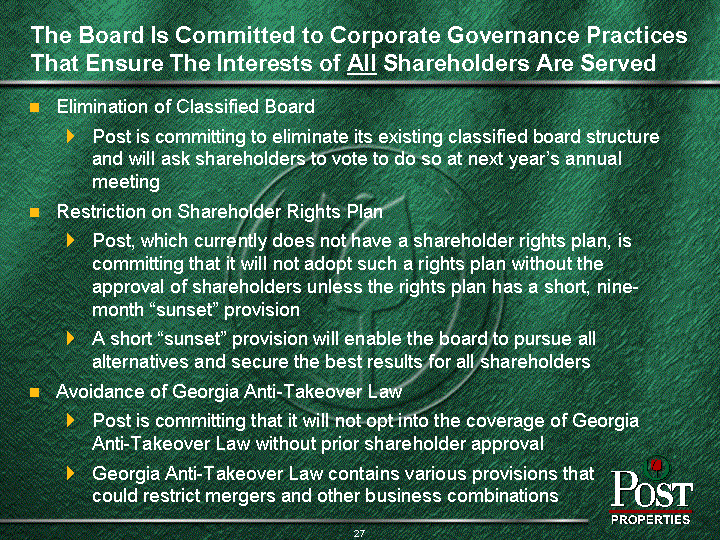
| The Board Is Committed to Corporate Governance Practices That Ensure The Interests of All Shareholders Are Served Elimination of Classified Board Post is committing to eliminate its existing classified board structure and will ask shareholders to vote to do so at next year's annual meeting Restriction on Shareholder Rights Plan Post, which currently does not have a shareholder rights plan, is committing that it will not adopt such a rights plan without the approval of shareholders unless the rights plan has a short, nine- month "sunset" provision A short "sunset" provision will enable the board to pursue all alternatives and secure the best results for all shareholders Avoidance of Georgia Anti-Takeover Law Post is committing that it will not opt into the coverage of Georgia Anti-Takeover Law without prior shareholder approval Georgia Anti-Takeover Law contains various provisions that could restrict mergers and other business combinations |
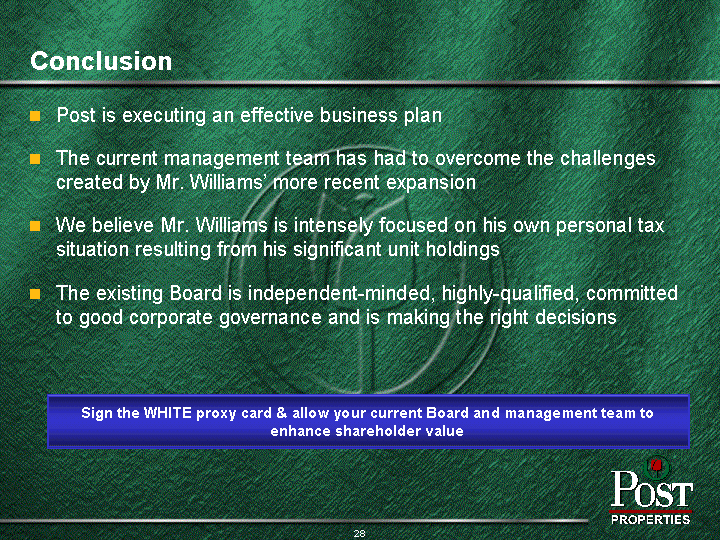
| Sign the WHITE proxy card & allow your current Board and management team to enhance shareholder value Conclusion Post is executing an effective business plan The current management team has had to overcome the challenges created by Mr. Williams' more recent expansion We believe Mr. Williams is intensely focused on his own personal tax situation resulting from his significant unit holdings The existing Board is independent-minded, highly-qualified, committed to good corporate governance and is making the right decisions |

| Appendix: Supplemental Information |

| Regulation G Disclosure The year-to-year percentage change in Same-Property Net Operating Income for the Atlanta and Dallas markets presented on page 11 is a non-GAAP financial measure. In this presentation, we define Net Operating Income as rental and other revenues from real estate operations less total property operating and maintenance expenses from real estate operations (exclusive of depreciation and amortization). We believe the most directly comparable GAAP measure demonstrating a year-to-year change in performance in these markets is the line item in our consolidated statements of operations entitled "Income From Continuing Operations Before Equity in Losses of Unconsolidated Entities, Gains on Property Sales and Minority Interest". A reconciliation of the year-to-year percentage change in Same-Property Net Operating Income for the Atlanta and Dallas Markets to the year-to-year percentage change in Income From Continuing Operations Before Equity In Losses of Unconsolidated Entities, Gains on Property Sales and Minority Interest is provided in Table 1. The information presented in Table 1 under the heading "Same-Property Net Operating Income (NOI) Summary by Market" demonstrates the differences between Same-Property Net Operating Income for the Atlanta and Dallas Markets versus Same-Property Net Operating Income for all of our Same-Property communities and calculates Same-Property Net Operating Income for the Atlanta and Dallas Markets using Same-Property Rental and Other Revenues and Same-Property Property Operating and Maintenance Expense. The Same-Property Net Operating Income numbers for Atlanta and Dallas presented in Table 1 under the heading "Same-Property Net Operating Income (NOI) by Market" are the numbers from which the year-to-year percentage change is calculated on page 11. The information presented in Table 1 under the heading "Reconciliation of Same-Property Net Operating Income (NOI) to Income from Continuing Operations before Equity in Losses of Unconsolidated Entities, Gains on Property Sales and Minority Interest" is a reconciliation of Same-Property Net Operating Income to the line item in our consolidated statements of operations entitled "Income From Continuing Operations Before Equity in Losses of Unconsolidated Entities, Gains on Property Sales and Minority Interest". Table 1 also provides a calculation of the year-to-year percentage change in Income From Continuing Operations Before Equity in Losses of Unconsolidated Entities, Gains on Property Sales and Minority Interest. |
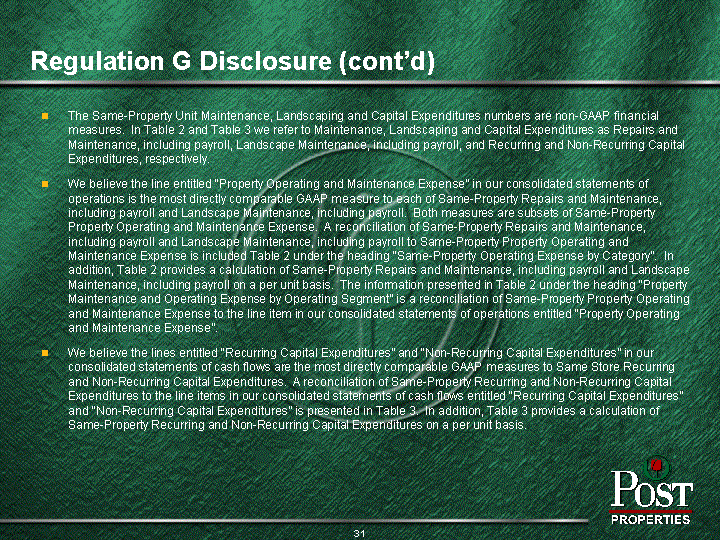
| Regulation G Disclosure (cont'd) The Same-Property Unit Maintenance, Landscaping and Capital Expenditures numbers are non-GAAP financial measures. In Table 2 and Table 3 we refer to Maintenance, Landscaping and Capital Expenditures as Repairs and Maintenance, including payroll, Landscape Maintenance, including payroll, and Recurring and Non-Recurring Capital Expenditures, respectively. We believe the line entitled "Property Operating and Maintenance Expense" in our consolidated statements of operations is the most directly comparable GAAP measure to each of Same-Property Repairs and Maintenance, including payroll and Landscape Maintenance, including payroll. Both measures are subsets of Same-Property Property Operating and Maintenance Expense. A reconciliation of Same-Property Repairs and Maintenance, including payroll and Landscape Maintenance, including payroll to Same-Property Property Operating and Maintenance Expense is included Table 2 under the heading "Same-Property Operating Expense by Category". In addition, Table 2 provides a calculation of Same-Property Repairs and Maintenance, including payroll and Landscape Maintenance, including payroll on a per unit basis. The information presented in Table 2 under the heading "Property Maintenance and Operating Expense by Operating Segment" is a reconciliation of Same-Property Property Operating and Maintenance Expense to the line item in our consolidated statements of operations entitled "Property Operating and Maintenance Expense". We believe the lines entitled "Recurring Capital Expenditures" and "Non-Recurring Capital Expenditures" in our consolidated statements of cash flows are the most directly comparable GAAP measures to Same Store Recurring and Non-Recurring Capital Expenditures. A reconciliation of Same-Property Recurring and Non-Recurring Capital Expenditures to the line items in our consolidated statements of cash flows entitled "Recurring Capital Expenditures" and "Non-Recurring Capital Expenditures" is presented in Table 3. In addition, Table 3 provides a calculation of Same-Property Recurring and Non-Recurring Capital Expenditures on a per unit basis. |
Reconciliation of Non-GAAP Financial Measures — Table 1
Same-Property Net Operating Income (NOI)
Summary by Market
| % | % | |||||||||||||||||||||||||
| 4Q02(1) | 4Q01(1) | Change | 3Q02(1) | 3Q01(1) | Change | |||||||||||||||||||||
| Rental and other revenues(A) | ||||||||||||||||||||||||||
| Atlanta | $ | 37,455 | $ | 40,323 | $ | 40,485 | $ | 44,102 | ||||||||||||||||||
| Dallas | 13,187 | 13,611 | 13,582 | 14,058 | ||||||||||||||||||||||
| Other | 12,113 | 13,076 | 12,440 | 13,082 | ||||||||||||||||||||||
| Total rental and other revenues | $ | 62,755 | $ | 67,010 | $ | 66,507 | $ | 71,242 | ||||||||||||||||||
| Property operating and maintenance expenses (exclusive of depreciation and amortization)(B) | ||||||||||||||||||||||||||
| Atlanta | $ | 12,674 | 12,066 | $ | 13,684 | $ | 13,242 | |||||||||||||||||||
| Dallas | 4,529 | 6,065 | 5,608 | 5,655 | ||||||||||||||||||||||
| Other | 4,119 | 4,556 | 4,561 | 4,572 | ||||||||||||||||||||||
| Total | $ | 21,322 | $ | 22,687 | $ | 23,853 | $ | 23,469 | ||||||||||||||||||
| Net operating income (A-B) | ||||||||||||||||||||||||||
| Atlanta | $ | 24,781 | $ | 28,257 | (12.3 | %) | $ | 26,801 | $ | 30,860 | (13.2 | %) | ||||||||||||||
| Dallas | 8,658 | 7,546 | 14.7 | % | 7,974 | 8,403 | (5.1 | %) | ||||||||||||||||||
| Other | 7,994 | 8,520 | (6.2 | %) | 7,879 | 8,510 | (7.4 | %) | ||||||||||||||||||
| Total | $ | 41,433 | $ | 44,323 | (6.5 | %) | $ | 42,654 | $ | 47,773 | (10.7 | %) | ||||||||||||||
Property Net Operating Income (NOI)
Summary by Operating Segment
| % | % | ||||||||||||||||||||||||
| 4Q02(1) | 4Q01(1) | Change | 3Q02(2) | 3Q01(2) | Change | ||||||||||||||||||||
| Total same property NOI | $ | 41,433 | $ | 44,323 | $ | 42,654 | $ | 47,773 | |||||||||||||||||
| Property NOI from other operating segments | 8,754 | 7,464 | 8,506 | 9,103 | |||||||||||||||||||||
| Consolidated property NOI | 50,187 | 51,787 | 51,160 | 56,876 | |||||||||||||||||||||
| Add: | |||||||||||||||||||||||||
| Interest income | 286 | 414 | 316 | 370 | |||||||||||||||||||||
| Revenues from third party services | — | 2,149 | — | 3,981 | |||||||||||||||||||||
| Less: | |||||||||||||||||||||||||
| Depreciation | (23,451 | ) | (18,255 | ) | (22,464 | ) | (18,192 | ) | |||||||||||||||||
| Interest | (16,343 | ) | (12,755 | ) | (15,763 | ) | (13,101 | ) | |||||||||||||||||
| Amortization of deferred loan costs | (616 | ) | (522 | ) | (588 | ) | (513 | ) | |||||||||||||||||
| General and administrative | (3,451 | ) | (3,810 | ) | (3,495 | ) | (3,441 | ) | |||||||||||||||||
| Minority interest in consolidated property partnerships | 576 | 754 | 537 | 527 | |||||||||||||||||||||
| Other expenses | (694 | ) | — | — | — | ||||||||||||||||||||
| Project abandonment, employee severance and impairment charges | — | (17,450 | ) | — | — | ||||||||||||||||||||
| Expenses of third party services | — | (2,394 | ) | — | (3,676 | ) | |||||||||||||||||||
| Income from Continuing Operations | |||||||||||||||||||||||||
| before Equity in Losses of Unconsolidated Entities, Gains on Property Sales and Minority Interest | $ | 6,494 | $ | (82 | ) | 8019.5 | % | $ | 9,703 | $ | 22,831 | (57.5 | %) | ||||||||||||
| (1) | Information derived from Post Properties’ earnings releases and Supplemental Financial Data Packages for the periods ended 9/30/02 and 12/31/02 (posted on the Company’s website www.postproperties.com) and company records | |
| (2) | Information derived from the Post Properties’ Form 10-Q filing for the period ended ended 9/30/02 |
$ in thousands, except per unit data
[POST LOGO]
32
Reconciliation of Non-GAAP Financial Measures — Table 2
Same-Property Operating Expenses by Category
| 2002(1) | 2001(1) | ||||||||
| Property operating and maintenance expenses (exclusive of depreciation and amortization) | |||||||||
| Personnel, promotion and utilities | $ | 29,881 | $ | 29,158 | |||||
| Repairs and maintenance, including payroll (A) | 15,665 | 16,695 | |||||||
| Landscape maintenance, including payroll (B) | 5,236 | 5,349 | |||||||
| Property taxes, licenses, insurance and other | 38,470 | 38,008 | |||||||
| Total — same property communities | $ | 89,252 | $ | 89,210 | |||||
| Per unit amounts (using 22,618 apartment units) | |||||||||
| Repairs and maintenance, including payroll (A/22,618) | $ | 693 | $ | 738 | |||||
| Landscape maintenance, including payroll (B/22,618) | $ | 232 | $ | 236 | |||||
Property Maintenance and Operating Expenses by Operating Segment
| 2002(1) | 2001(1) | |||||||||
| Property operating and maintenance expenses (exclusive of depreciation and amortization) | ||||||||||
| Same property communities | $89,252 | $89,210 | ||||||||
| Communities stabilized in prior year | 5,907 | 6,003 | ||||||||
| Lease-up communities | 16,379 | 10,429 | ||||||||
| Sold communities | 376 | 7,329 | ||||||||
Other(2) | 19,455 | 16,230 | ||||||||
| Total | $ | 131,369 | $ | 129,201 | ||||||
| Per consolidated statements of operations | ||||||||||
| Property operating and maintenance expenses (exclusive of depreciation and amortization) | $ | 131,369 | $ | 129,201 | ||||||
| (1) | Information derived from the Post Properties’ Form 10-K filing for the year ended 12/31/02 and company records | |
| (2) | Includes central office personnel and operating expenses related to property management and maintenance functions of $11,911 and $10,294 for the years ended December 31, 2002 and 2001, respectively. Also includes expenses from commercial properties and costs associated with furnished apartment rentals |
$ in thousands, except per unit data
[POST LOGO]
33

| Reconciliation of Non-GAAP Financial Measures - Table 3 (1) Information derived from the Post Properties' Form 10-K filing for the year ended 12/31/02 and company records (2) Consists of commercial properties and assets classified as discontinued operations under SFAS No. 144 $ in thousands, except per unit data Property Capital Expenditures by Operating Segment |